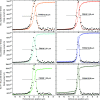Polished diamond X-ray lenses
- PMID: 35510996
- PMCID: PMC9070707
- DOI: 10.1107/S1600577522001795
Polished diamond X-ray lenses
Abstract
High-quality bi-concave 2D focusing diamond X-ray lenses of apex-radius R = 100 µm produced via laser-ablation and improved via mechanical polishing are presented here. Both for polished and unpolished individual lenses and for stacks of ten lenses, the remaining figure errors determined using X-ray speckle tracking are shown and these results are compared with those of commercial R = 50 µm beryllium lenses that have similar focusing strength and physical aperture. For two stacks of ten diamond lenses (polished and unpolished) and a stack of eleven beryllium lenses, this paper presents measured 2D beam profiles out of focus and wire scans to obtain the beam size in the focal plane. These results are complemented with small-angle X-ray scattering (SAXS) measurements of a polished and an unpolished diamond lens. Again, this is compared with the SAXS of a beryllium lens. The polished X-ray lenses show similar figure errors to commercially available beryllium lenses. While the beam size in the focal plane is comparable to that of the beryllium lenses, the SAXS signal of the polished diamond lenses is considerably lower.
Keywords: X-ray lenses; compound refractive lenses; diamond.
open access.
Figures




















References
-
- Alianelli, L., Sawhney, K. J. S., Malik, A., Fox, O. J. L., May, P. W., Stevens, R., Loader, I. M. & Wilson, M. C. (2010). J. Appl. Phys. 108, 123107.
-
- Andrejczuk, A., Krzywiński, J., Sakurai, Y. & Itou, M. (2010). J. Synchrotron Rad. 17, 616–623. - PubMed
-
- Antipov, S., Assoufid, L., Grizolli, W., Qian, J. & Shi, X. (2018). Proceedings of the 9th International Particle Accelerator Conference (IPAC’18), 29 April–4 May 2018, Vancouver, BC, Canada, pp. 4057–4058. THPMF011.
-
- Artemiev, A., Snigirev, A., Kohn, V., Snigireva, I., Artemiev, N., Grigoriev, M., Peredkov, S., Glikin, L., Levtonov, M., Kvardakov, V., Zabelin, A. & Maevskiy, A. (2006). Rev. Sci. Instrum. 77, 063113.
Grants and funding
LinkOut - more resources
Full Text Sources
Miscellaneous

